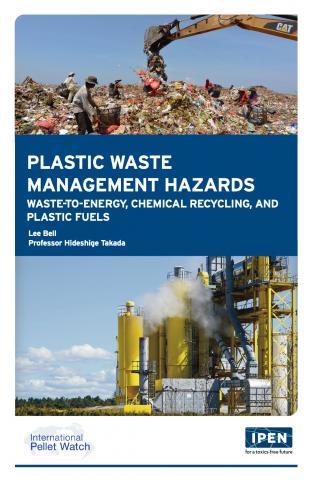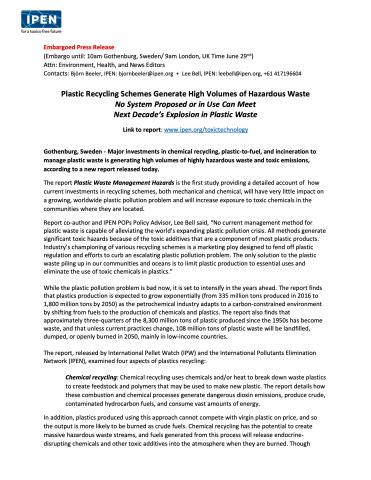Plastic Recycling Schemes Generate High Volumes of Hazardous Waste

Gothenburg, Sweden Major investments in chemical recycling, plastic-to-fuel, and incineration to manage plastic waste is generating high volumes of highly hazardous waste and toxic emissions, according to a new report released today.
The report Plastic Waste Management Hazards is the first study providing a detailed account of how current investments in recycling schemes, both mechanical and chemical, will have very little impact on a growing, worldwide plastic pollution problem and will increase exposure to toxic chemicals in the communities where they are located.
Report co-author and IPEN POPs Policy Advisor, Lee Bell said, “No current management method for plastic waste is capable of alleviating the world’s expanding plastic pollution crisis. All methods generate significant toxic hazards because of the toxic additives that are a component of most plastic products. Industry’s championing of various recycling schemes is a marketing ploy designed to fend off plastic regulation and efforts to curb an escalating plastic pollution problem. The only solution to the plastic waste piling up in our communities and oceans is to limit plastic production to essential uses and eliminate the use of toxic chemicals in plastics.”
While the plastic pollution problem is bad now, it is set to intensify in the years ahead. The report finds that plastics production is expected to grow exponentially (from 335 million tons produced in 2016 to 1,800 million tons by 2050) as the petrochemical industry adapts to a carbon-constrained environment by shifting from fuels to the production of chemicals and plastics. The report also finds that approximately three-quarters of the 8,300 million tons of plastic produced since the 1950s has become waste, and that unless current practices change, 108 million tons of plastic waste will be landfilled, dumped, or openly burned in 2050, mainly in low-income countries.
- Chemical recycling. Chemical recycling uses chemicals and/or heat to break down waste plastics to create feedstock and poly¬mers that may be used to make new plastic. The report details how these combustion and chemical processes generate dangerous dioxin emissions, produce crude, contaminated hydrocarbon fuels, and consume vast amounts of energy.
In addition, plastics produced using this approach cannot compete with virgin plastic on price, and so the output is more likely to be burned as crude fuels. Chemical recycling has the potential to create massive hazardous waste streams, and fuels generated from this process will release endocrine-disrupting chemicals and other toxic additives into the atmosphere when they are burned. Though chemical recycling proponents claim that contaminants and toxic additives can be “separated” from the waste plastic during processing, this will comprise a new, high-volume hazardous waste stream. - Plastics to Fuels. As plastic waste stockpiles grow at unprecedented rates around the world, many proponents are pushing for the adoption of fuels derived from plastic waste to ‘substitute’ for fossil fuels and to offset oil, gas, and coal extraction. The reality is that in all but a few cases the resulting product is hydrocarbon fuel or simply a repackaged form of plastic waste rebranded as a ‘product’ instead of a ‘waste’ for financial, regulatory, or subsidy purposes. The report concludes that these practices are inefficient, polluting, and uneconomical. Similarly, recovering energy from burning plastic waste in incinerators and cement kilns as ‘al¬ternate fuels’ or ‘refuse-derived fuels’ results in toxic emissions, toxic ash, high-intensity carbon releases, and wastes resources.
- Mechanical recycling. Only a small percentage of plastic ends up being recycled through traditional mechanical recycling. Most is burned or landfilled because most plastics being recycled contain toxic chemical additives that contaminate the final recyclate and are difficult to use in the production of new plastic products, reducing its quality. As a result, large amounts of plastic waste contaminated with brominated flame retardants and persistent organic pollutant (POPs) additives are shipped to landfills or incinerators, often in developing countries. The process of handling, cleaning, and grinding plastics also exposes workers to hazardous dust and vapours. The whole process shifts the responsibility for handling the toxic impact of recycling away from the plastic producers and onto the recyclers who struggle to process many unrecyclable or difficult-to-manage plastics.
- Chemical additives in plastics represent an extreme hazard in all current recycling methods. Additives to plastics include colouring, plasticizers, and UV stabilisers and other chemicals used to impart certain properties to the finished plastic product. Many of these chemicals are toxic. A widely used UV stabiliser, UV 328, for example, has been identified as one of the world’s most toxic chemicals and is listed-up as a candidate POP to be regulated by the Stockholm Convention. This chemical is widespread in plastic waste and a monitoring program run by International Pellet Watch has detected its presence across the world’s oceans and beaches.
Report co-author and leading international scientist on hazardous chemicals and plastics, Professor Shige Takada said, “We are finding plastic’s toxic chemicals across the world’s oceans, coastlines and in the isolated polar regions. Fish and seabirds swallow plastic waste contaminated by these toxic UV stabilisers, and it builds up in the food chain. It is very concerning and must be prohibited internationally. Our studies show that plastic waste is not inert, it transports the toxic additives for thousands of miles impacting global ecosystems.”
The report concludes with three recommendations:
- Governments must acknowledge and immediately move to limit the growing amount of hazardous waste generated from plastic waste by dramatically reducing the amount of plastic industry can produce. An international treaty can achieve this.
- Governments must manage existing stockpiles of plastic waste (controlled, un¬controlled, and landfills) in an environmentally sound manner.
- Governments must drive industry to develop an environmentally sound, sustainable manage¬ment system for any plastic produced in the future. This must include implementation of design, production, and end-of-life management systems that maximize non-toxic polymer reuse and recycling in low-income countries as well as wealthy countries.
###

